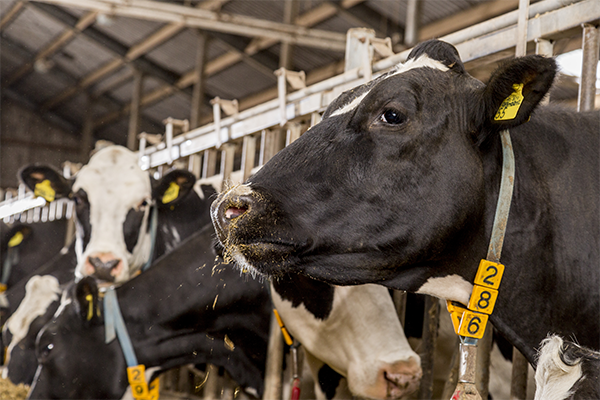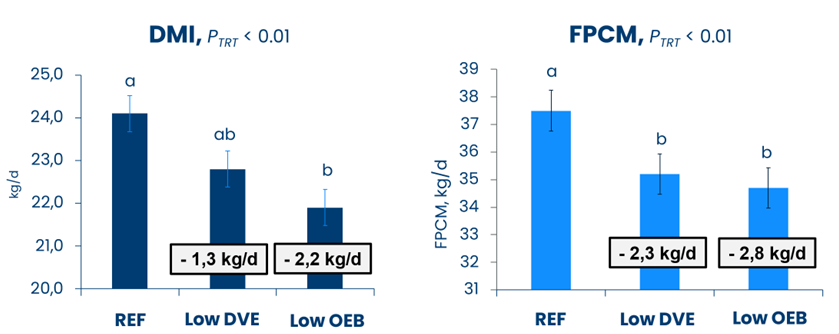Increasing nitrogen efficiency and impact on feed balance - part 1
- Ruminants
Because of the environmental impact and increasingly stringent regulations around nitrogen emissions, it is important that we feed our cows (even) more precisely in the future. The goal is to convert feed protein into milk protein as efficiently as possible. Efficient conversion not only results in savings on manure disposal costs, regardless of whether we calculate them through the urea track or the farm-specific excretions, but also in a higher feed balance, given protein is a costly component in the ration.

Within the Precision Feeding research pillar of our Sustainable Farming approach, protein efficiency is a major theme. Recently, a number of studies have been conducted on Trouw Nutrition's cattle research farm to increase nitrogen efficiency, focusing on the effects on dairy cow performance and feed balance. These studies, as well as Trouw Nutrition's new vision for amino acids, were also presented at a sustainability event we hosted in the Netherlands late last year.
In a first study, lower levels of crude protein in the ration were obtained by offering different concentrate feeds. 48 dairy cows were presented with three different TMR rations. The composition of the rations is shown in Table 1, where contrast in the ration was created by varying levels of protein in the supplemental concentrate. This resulted in a lower crude protein level of the two treatments. The lower crude protein level was achieved by either lower rumen digestible protein (OEB) or lower intestinal protein (DVE) levels (Table 2).
|
TMR composition |
% DM |
|
Concentrated feed |
42 |
|
Maize silage |
30 |
|
Grass silage |
20 |
|
Brewers’ grain |
4 |
|
Grass hay |
4 |
Table 1. Ration composition.
|
Nutrient |
CTR |
Low DVE |
Low OEB |
|
Crude protein (g/kg DM) |
16.6 |
14.5 |
14.4 |
|
DVE (g/kg DM) |
102 |
86 |
101 |
|
OEB (g/kg DM) |
6 |
0 |
-13 |
|
VEM (/kg DM) |
1027 |
1025 |
1026 |
Table 2. Ration composition.
The cows showed a significant decrease in both dry matter intake and milk production, with the effect being numerically greater in the low OEB group. The recommendation to reduce crude protein content first through lower OEB content was not confirmed in this trial. This can be partly explained by a significantly lower crude protein digestibility in the group with low OEB content, indicating that the digestibility of the rumen protected sources used was overestimated.

Figure 1. The effect of lowering protein content in rations (via concentrate) on dry matter intake (left) and measured milk (right) (Nichols et al., unpublished).
This study also confirmed that reducing crude protein content has a positive impact on decreasing nitrogen excretion through manure (Table 3). The feed balance, calculated with a milk price of €0.46 per liter, was lower by €0.7 to €0.8 per cow per day compared to the control group.
|
€/cow/day |
CTR |
Low DVE |
Low OEB |
|
Milk revenue (€/cow/day) |
13,4 |
12.6 |
12,3 |
|
Ration costs (€/cow/day) |
6,0 |
5.7 |
5,6 |
|
Income over feed cost (€/cow/day) |
7,3 |
6,8 |
6,7 |
|
Difference (€/cow/day) |
|
- 0.7 € |
- 0.8 € |
|
Reduction N excretion through manure (% vs. control) |
|
17% |
22% |
Table 3. The effect of reducing protein content in the ration (via concentrate) on efficiency (price level October 2023 - milk price €0.46 per liter) and reduction in N excretion through manure.
In the quest for higher nitrogen efficiency, reducing crude protein is a sensible strategy. However, this approach requires customization to ensure that the income over feed cost is maintained for the dairy farmer. That this can be accomplished well will be discussed in a subsequent article.
